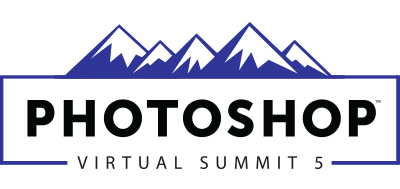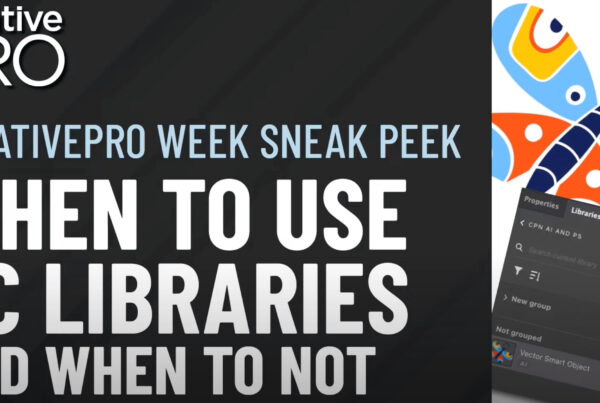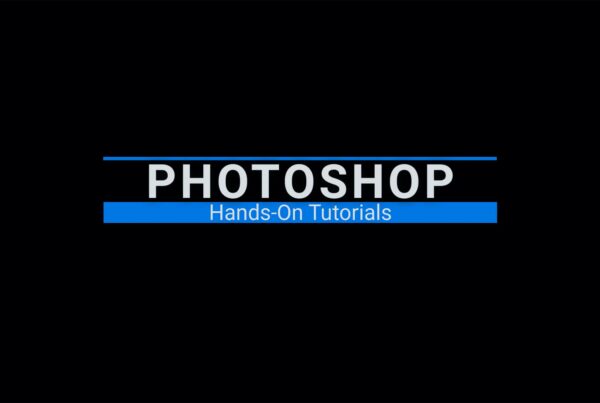
YES! Following these steps will significantly reduce the final size of your production files. I will illustrate using examples from a 40-foot trailer wrap project.
Start by making sure your image resolutionImage resolution measures the number of pixels in an image as it is displayed or printed. Pixels Per... More is no more than you need it to be. See article Large Format File Resolution.
Step One
Gather your high resolution collateral and total up the file sizes. This project began with 1.13 GB of image files.

The first and most important step is to combine the image files into a single photoshop layout at the correct print size and resolution (See article Large Format File Resolution.) This step alone will significantly reduce the amount of bytes used for your project. Combining the original high-res files in a Photoshop layout (built to scale) takes the total byte size for this project down to 668 MB. We have already reduced our production file size by 462 megs.

But wait, there’s more…
Step Two
Save a copy of your layered working Photoshop file to a .tiff format. Make sure Layers option is turned off. Also deselect Embed Color ProfileA profile is a file of data or values. A profile enables color consistently on various devices. More unless your printer has specified a specific profile.
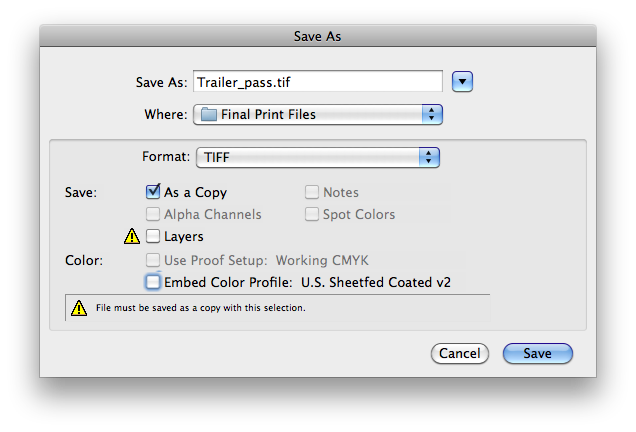
The second dialog box controls the size of your .tiff file. Under image compressionCompression removes information and reduces file size. Some types of compression can cause losses an... More choose LZW. This will compress areas in your design with solid color areas. If your layout has large areas of flat solid color you will see the most significant image compression. (I don’t use LZW compression for offset printingOffset printing is a common commercial printing process. CMYK inks are applied to printing plates an... More but find it works great for large format images.) Also make sure you are saving a copy by flattening your layers.
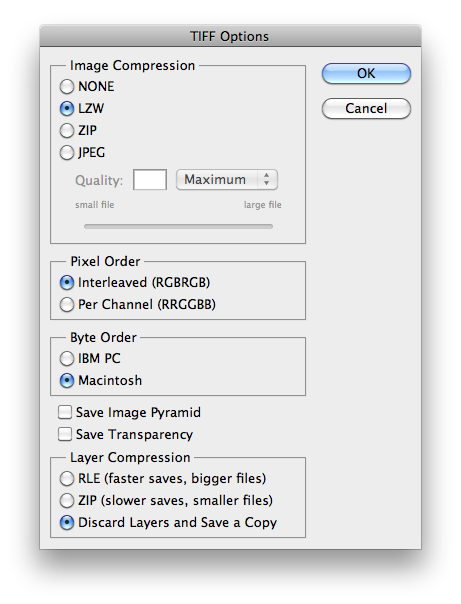
The compressed .tiff file is only 80.9 MG. Remember we started with image files that totaled 1.13 GB. We have reduced the image size of this project by nearly 1400%.
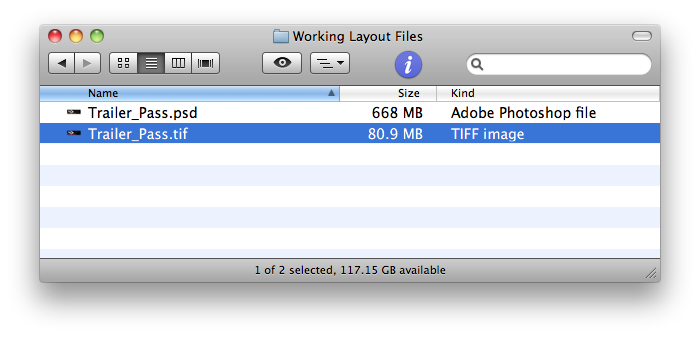
Step Three
Create an illustrator layout at the same print size as your Photoshop file. LINKLink describes a graphic asset file that is placed in a layout application without being embedded in... More your Photoshop.tiff file to your Illustrator layout. You can place text, logos and other vectorVector is a graphic format that does not contain pixels. It is created from mathematical equations a... More files on top of the linked tiffTIFF stands for Tag Image File Format. TIFF is a file format that can contain raster and vector grap... More file. I like to use separate layers for each.
Save a working copy of your illustrator file, retaining all your text as fonts (just in case you need to come back and make copy edtis).
Step Four
Outline all of your fonts and save a copy of your file for print. Save your file as a native illustrator aiThe file extension for a native Adobe Illustrator file is .ai. AI is short for Adobe Illustrator. (A... More. file. In the save dialog box uncheck the first option “Create PDFPDF is short for Portable Document Format. More Compatible File.”
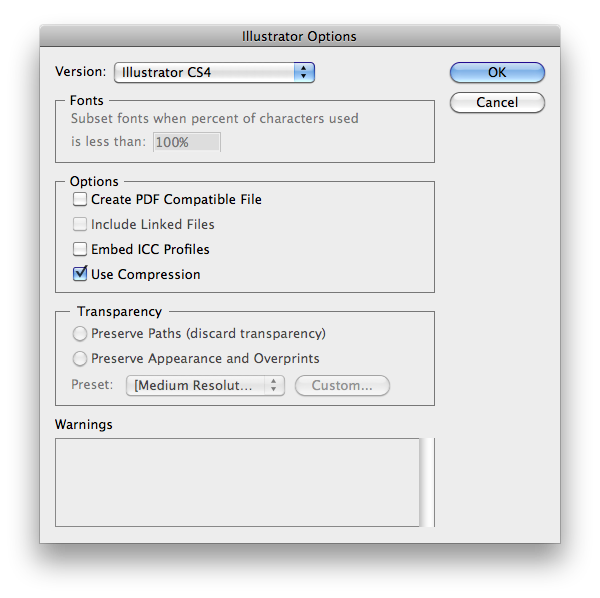
Illustrator default saves a PDF compatible file. Turning this option off will siginificantly reduce the size of your file. It will not change or damage your file in anyway. You will loose the pict preview that allows you to view it from your desktop, create a .pdf from Acrobat or place it into inDesign, but you don’t need these options for your final print file. The megabytes you will save is more than worth losing the pict preview.
Why not save the final layout as an epsEPS is short for Encapsulated Postscript. The file format was created by Adobe in the late 1980s t... More?
Many printers will ask for eps files because they need an eps file for their RIPRIP is short for Raster Image Processor. A RIP is software that communicates between a computer and ... More. The truth is that any good prepress department is going to open your layout file and examine it before sending it to print. If they are going to open your file,then why not have them save the eps file? Saving ai files without .pdf compatibility siginificantly reduces overall file sizes saving transfer times on both the upload and the download. Your ai file will also open much faster for your printer saving their preflight department time as well.
The sample trailer file saved as an eps file is 353.2 MB. The native ai file without PDF comaptibility is only 213 KB.
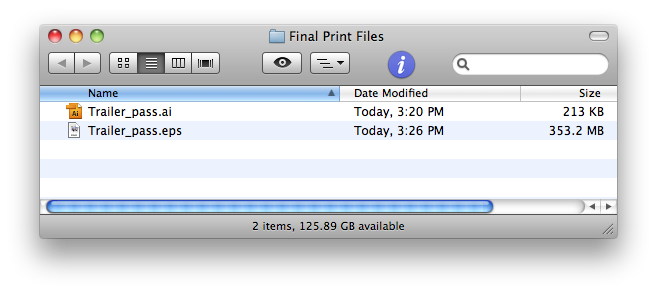
Success
You are ready to send your project to the printer. All the printer needs is your Illustrator layout and the Photoshop tiff file. This project started with over a gig of information and now the print ready files total less than 100 MB. With todays high speed connections, a job this size will only take a matter of minutes to upload or download, saving you and your printer valuable time.

